Sustainability Multivariate Analysis of the Energy Consumption of Ecuador Using MuSIASEM and BIPLOT Approach
Abstract
:1. Introduction
2. Materials and Methods
2.1. Case Study: Ecuador
2.2. Multi-Scale Integrated Analysis of Societal and Ecosystem Metabolism (MuSIASEM)
2.3. Database
2.4. HJ-Biplot Method
3. Results
3.1. MuSIASEM Approach
3.1.1. Level n: Whole Society
3.1.2. Level n − 1: Paid Work Sectors (PW) and Household Sectors (HH)
3.1.3. Level n − 2: Productive Sectors
3.2. Biplot Method
3.3. Added Value of Using HJ-Biplot Together with MuSIASEM Approach
4. Discussion
5. Conclusions
- The use of the Multi-Scale Integrated Analysis of Societal and Ecosystem Metabolism (MuSIASEM) approach with the HJ-Biplot allows us to easily know the detailed behavior of the labor productivity and energy consumption (in our case) of a country.
- With the MuSIASEM approach we cannot put all of the 221 individual cantons and 26 variables in one graphic, whereas with the HJ-Biplot method it possible to plot the rows (individuals) and columns (variables) of the data matrix as points on a low dimension vectorial space. With the combination of the two approaches we can easily know the detailed behavior of the labor productivity and energy consumption (in our case) of a country.
- In the case of Ecuador, using HJ-Biplot we found that the first gradient of MuSIASEM indicators are associated with: the Energy Throughput per economic sector, Total Human Activity, Human Activity in Productive sector and Service and Government sector, Human activity in Household and Gross Domestic Product in Agriculture sector and Service and Government sector; and the second gradient is associated with Economic Labor Productivity and the Exosomatic Metabolic Rate.
- In the HJ-Biplot, axis 2, associated with Economic Labor Productivity (ELP) and the Exosomatic Metabolic Rate (EMR) of Ecuador, indicated a clear link between ELP and the EMR. Places (cantons) with high values of ELP will have high values in EMR.
- We found that the cantons of Guayaquil and Quito have high values in the MuSIASEM variables related to the THA, GDP and EMR, in comparison with the other cantons.
- In Ecuador the highest values of the Exosomatic Metabolic Rate per economic sector (EMR) and Economic Labor Productivity are located in the Productive Sector (PS).
- The highest metabolic pattern in Exosomatic Metabolic Rate (EMRHH) of households in Ecuador is located in Manabí province, showing that the most of the increase in energy consumption was directed to increasing the material of standard living.
Acknowledgments
Author Contributions
Conflicts of Interest
References
- Millennium Ecosystem Assessment. Ecosystems and Human Well-Being: Synthesis; Island Press: Washington, DC, USA, 2005; Volume 5, pp. 1–2. [Google Scholar]
- Kates, R.W.; Clark, W.C.; Corell, R.; Hall, J.M.; Jaeger, C.C.; Lowe, I.; McCarthy, J.J.; Schellnhuber, H.J.; Bolin, B.; Dickson, N.M.; et al. Sustainability Science. Sci. New Ser. 2001, 292, 641–642. [Google Scholar] [CrossRef]
- Brundtland, G.H. Report of the World Commission on Environment and Development: Our Common Future (The Brundtland Report). Med. Confl. Surviv. 1987, 4, 16. [Google Scholar]
- Giampietro, M.; Aspinall, R.J.; Ramos-Martin, J.; Bukkens, S.G.F. Resource Accounting for Sustainability Assessment: The Nexus Between Energy, Food, Water and Land Use, 1st ed.; Routledge: Abingdon, UK, 2014; pp. 1–270. [Google Scholar]
- Flammini, A.; Puri, M.; Pluschke, L.; Dubois, O. Walking the Nexus Talk: Assessing the Water-Energy-Food Nexus in the Context of the Sustainable Energy for All Initiative; Food and Agriculture Organization of the United Nations: Rome, Italy, 2014. [Google Scholar]
- Food and Agriculture Organization of the United Nations. The Water-Energy-Food Nexus-A New Approach in Support of Food Security and Sustainable Agriculture, 1st ed.; Food and Agriculture Organization of the United Nations: Rome, Italy, 2014; pp. 1–9. [Google Scholar]
- IRENA. Renewable Energy in the Water, Energy and Food Nexus; International Renewable Energy Agency: Abu Dhabi, UAE, 2015; pp. 12–13. [Google Scholar]
- World Energy Assessment. Energy and the Challenge of Sustainability; United Nations Development Programme: New York, NY, USA, 2000; pp. 1–7. [Google Scholar]
- Iorgulescu, R.I. Poverty, Socioeconomic Metabolism, and the Multi-scale Integrated Analysis Approach. Proc. Econ. Financ. 2014, 8, 407–413. [Google Scholar] [CrossRef]
- Cadillo Benalcazar, J.J. El Uso de la Gramática del MuSIASEM para el Análisis Cuantitativo de la Sostenibilidad de los Sistemas Alimentarios. Ph.D. Thesis, Doctorado en Ciencia y Tecnologías Ambientales, Universitat Autònoma de Barcelona, Barcelona, Spain, 2015. [Google Scholar]
- Falconí-Benítez, F. Integrated Assessment of the Recent Economic History of Ecuador. Popul. Environ. 2001, 22, 257–280. [Google Scholar] [CrossRef]
- Ramos-Martin, J.; Giampietro, M.; Mayumi, K. On China’s exosomatic energy metabolism: An application of multi-scale integrated analysis of societal metabolism (MSIASM). Ecol. Econ. 2007, 63, 174–191. [Google Scholar] [CrossRef]
- Ramos-Martín, J.; Cañellas-Boltà, S.; Giampietro, M.; Gamboa, G. Catalonia’s energy metabolism: Using the MuSIASEM approach at different scales. Energy Policy 2009, 37, 4658–4671. [Google Scholar] [CrossRef]
- Gasparatos, A.; El-Haram, M.; Horner, M. Assessing the sustainability of the UK society using thermodynamic concepts: Part 1. Renew. Sustain. Energy Rev. 2009, 13, 1074–1081. [Google Scholar] [CrossRef]
- Sorman, A.H.; Giampietro, M. Generating better energy indicators: Addressing the existence of multiple scales and multiple dimensions. Ecol. Model. 2011, 223, 41–53. [Google Scholar] [CrossRef]
- Recalde, M.; Ramos-Martin, J. Going beyond energy intensity to understand the energy metabolism of nations: The case of Argentina. Energy 2012, 37, 122–132. [Google Scholar] [CrossRef]
- Biggs, E.M.; Bruce, E.; Boruff, B.; Duncan, J.M.A.; Horsley, J.; Pauli, N.; McNeill, K.; Neef, A.; Van Ogtrop, F.; Curnow, J.; et al. Sustainable development and the water-energy-food nexus: A perspective on livelihoods. Environ. Sci. Policy 2015, 54, 389–397. [Google Scholar] [CrossRef]
- Gabriel, K.R. The Biplot-Graphic Display of Matrices with Application to Principal Component Analysis. Biometrika 1971, 58, 453–467. [Google Scholar] [CrossRef]
- Galindo, P. Una representación simultánea: HJ Biplot. Qttestió 1986, 10, 13–23. [Google Scholar]
- Larrea, C. The Mirage of Development: Oil, Employment, and Poverty in Ecuador, 1972–1990. Ph.D. Thesis, York University, Toronto, ON, Canada, 1992. [Google Scholar]
- Falconi, F.; Jácome, H. La invitada indiscreta de la dolarización en Ecuador: La competitividad. Soc. Econ. Fac. Cienc. Soc. Econ. Univ. Val. 2002, 3, 19–34. [Google Scholar]
- Falconí Benítez, F.; (Facultad Latinoamericana de Ciencias Sociales, Quito, Ecuador); Larrea, C.; (Facultad Latinoamericana de Ciencias Sociales, Quito, Ecuador). Impactos ambientales de las politicas de Liberalizacion externa y los flujos de capital: El caso de Ecuador. Globalizacion y desarrollo en América Latina. Personal communication, 2003. [Google Scholar]
- Ramos-Martín, J. Historical Analysis of Energy Intensity of Spain: From a “Conventional View” to an “Integrated Assessment”. Popul. Environ. 2001, 22, 281–313. [Google Scholar] [CrossRef]
- Eisenmenger, N. Análisis del metabolismo energético y de materiales de Brasil, Chile y Venezuela. Rev. Iberoam. Econ. Ecol. 2007, 6, 17–39. [Google Scholar]
- Giampietro, M.; Institute for Environmental Science and Technology, Autonomous University of Barcelona, Barcelona, Spain; Mayumi, K.; University of Tokushima, Tokushima City, Japan; Ramos-Martín, J.; Department of Applied Economics and Institute for Environmental Science and Technology, Autonomous University of Barcelona, Barcelona, Spain. Multi-Scale Integrated Analysis of Societal and Ecosystem Metabolism (MUSIASEM): An Outline of Rationale and Theory. Personal communication, 2008. [Google Scholar]
- Giampietro, M.; Mayumi, K. A dynamic model of socioeconomic systems based on hierarchy theory and its application to sustainability. Struct. Chang. Econ. Dyn. 1997, 8, 453–469. [Google Scholar] [CrossRef]
- Giampietro, M.; Mayumi, K. Multiple-scale integrated assesment of societal metabolism: Introducing the approach. Popul. Environ. 2000, 22, 109–153. [Google Scholar] [CrossRef]
- Giampietro, M.; Mayumi, K. Multiple-scale integrated assessments of societal metabolism: Integrating biophysical and economic representations across scales. Popul. Environ. 2000, 22, 155–210. [Google Scholar] [CrossRef]
- Georgescu-Roegen, N. The Entropy law and the Economic Process in Retrospect. East. Econ. 1986, 12, 3–25. [Google Scholar]
- Georgescu-Roegen, N. Myth about Energy and Matter. Growth Chang. 1979, 10, 16–23. [Google Scholar] [CrossRef]
- Maturana, H.R.; Varela, F.J. Autopoesis and Cognition. The Realization of the Living. Boston Stud. Philos. Hist. Sci. 1980, 42, 59–138. [Google Scholar]
- Giampietro, M. Multi-Scale Integrated Analysis of Agroecosystems, 1st ed.; CRC Press: Boca Raton, FL, USA, 2003. [Google Scholar]
- Ginard-Bosch, F.J.; Ramos-Martín, J. Energy metabolism of the Balearic Islands (1986–2012). Ecol. Econ. 2016, 124, 25–35. [Google Scholar] [CrossRef]
- Banco Central del Ecuador. Cuentas Regionales. 2015. Available online: https://goo.gl/hAIu7N (accessed on 14 March 2017).
- Agencia de Regulación y Control de Electricidad. Estadísticas del Sector Eléctrico. 2015. Available online: https://goo.gl/fQX0F9 (accessed on 14 March 2017).
- Instituto Nacional de Estadísticas y Censos. Censo de Población y Vivienda 2010. Available online: https://goo.gl/OJd6Qa (accessed on 14 March 2017).
- Instituto Nacional de Estadísticas y Censos. Encuesta Nacional de Empleo, Desempleo y Subempleo 2010. Available online: https://goo.gl/jm5SJa (accessed on 14 March 2017).
- Galante, E.; Garcia-Roman, M.; Barrera, I.; Galindo, P. Comparison of spatial distribution patterns of dung-feeding scarabs (Coleoptera: Scarabaeidae, Geotrupidae) in wooded and open pastureland in the Mediterranean “Dehesa” area of the Iberian Peninsula. Environ. Entomol. 1991, 20, 90–97. [Google Scholar] [CrossRef]
- Castela, E.; Villardón, M.P. Inferencia Ecológica para la Caracterización de Abstencionistas: El Caso de Portugal. Ph.D. Thesis, Departameno de Estadística, Universidad de Salamanca, Salamanca, España. Available online: http://gredos.usal.es/jspui/handle/10366/76426 (accessed on 14 March 2017).
- Lodoño Correa, G.; Lavalett Oñate, L.L.; Galindo Villardón, M.P.; Afanador Kafuri, L. Uso de Métodos Multivariantes para la Agrupación de Aislamientos de Colletotrichum spp. con base en Caraterísticas Morfológicas y Culturales. Rev. Fac. Nac. Agron. 2007, 60, 3671–3690. [Google Scholar]
- Nieto, A.B.; Galindo-Villardón, M.; Leiva, V.; Vicente-Galindo, M. A Methodology for Biplots based on bootstrapping with R. Rev. Colomb. Estad. 2014, 37, 367–397. [Google Scholar] [CrossRef]
- Instituto Nacional de Estadísticas y Censos. Fascículo Provincial Manabí. Ecuador en cifras INEC. 2010. Available online: https://goo.gl/vjNOyI (accessed on 26 March 2017).
- Velasco-Fernández, R.; Ramos-Martín, J.; Giampietro, M. The energy metabolism of China and India between 1971 and 2010: Studying the bifurcation. Renew. Sustain. Energy Rev. 2015, 41, 1052–1066. [Google Scholar] [CrossRef]
- Nieto Librero, A.B.; Galindo Villardon, P. R Package: Bootstrap on Classical Biplots and Clustering Disjoint Biplot; Departamento de Estadística, Universidad de Salamanca: Salamanca, Spain, 2015. [Google Scholar]
- Banco Central de Ecuador. Resultados de las Cuentas Ncionales. Dirección de Comunicación Social. 2014. Available online: https://goo.gl/Q16SzF (accessed on 26 March 2017).
- Gobierno Provincial del Guayas. Guayaquil. Available online: https://goo.gl/5Unm55 (accessed on 26 March 2017).
- Inistituto Nacional de Estadísticas y Censos. Ecuador en Crifras. 2010. Available online: http://www.ecuadorencifras.gob.ec/resultados/ (accessed on 26 March 2017).
- Clevelan, C.J.; Costanza, R.; Hall, C.A.S.; Kaufman, R. Energy and the U.S. Economy: A Biophysical Perspective. Science 1984, 225, 890–897. [Google Scholar] [CrossRef] [PubMed]
- Hall, C.A.S.; Clevelan, C.J.; Kaufman, R. Energy and Resource Quality: The Ecology of Economic Process. Land Econ. 1988, 64, 311–313. [Google Scholar] [CrossRef]
- Kaufman, R. A Biophysical Analysis of the Energy/Real GDP ratio: Implications for Substitution and Technical Change. Ecol Econ. 1992, 6, 35–56. [Google Scholar] [CrossRef]
- Petroecuador. Informe Estadístico 2015. Available online: http://www.eppetroecuador.ec/?p=2980 (accessed on 26 March 2017).

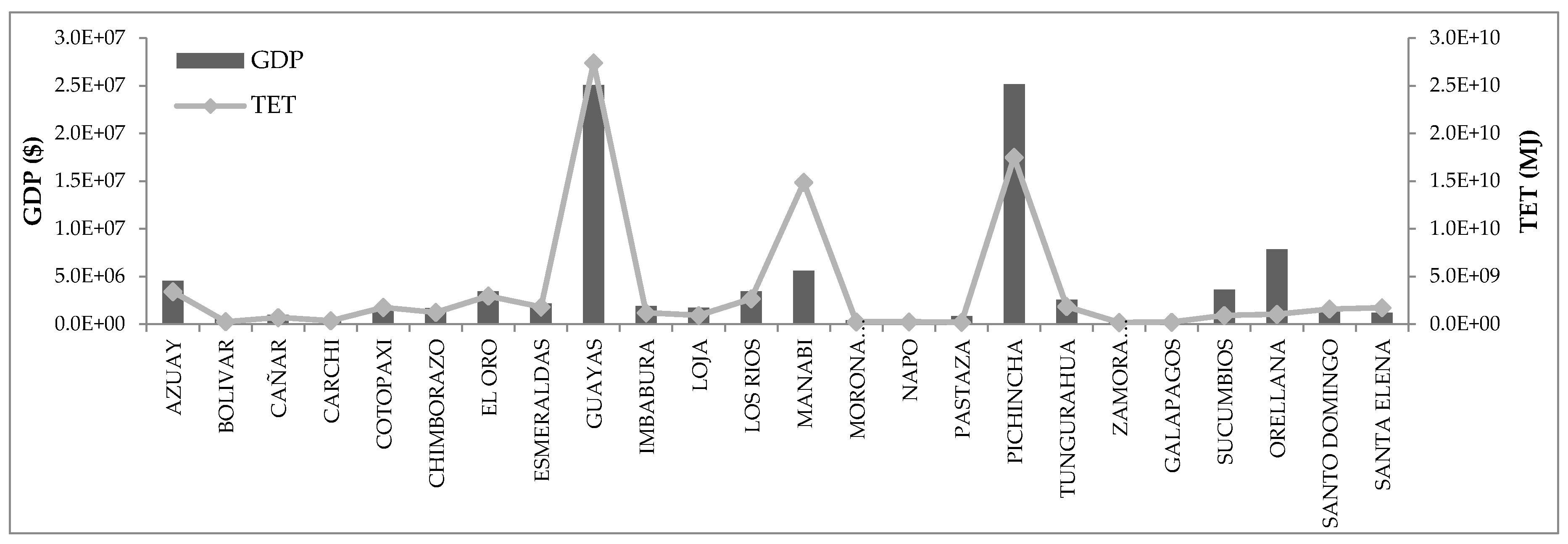
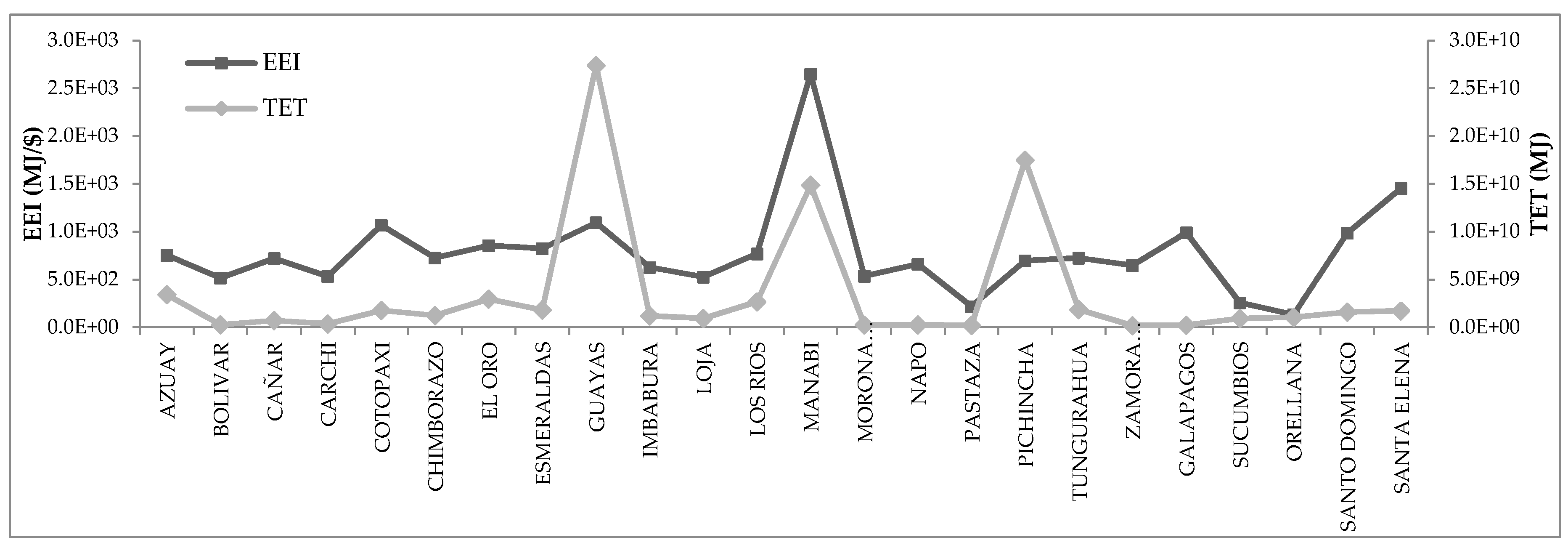
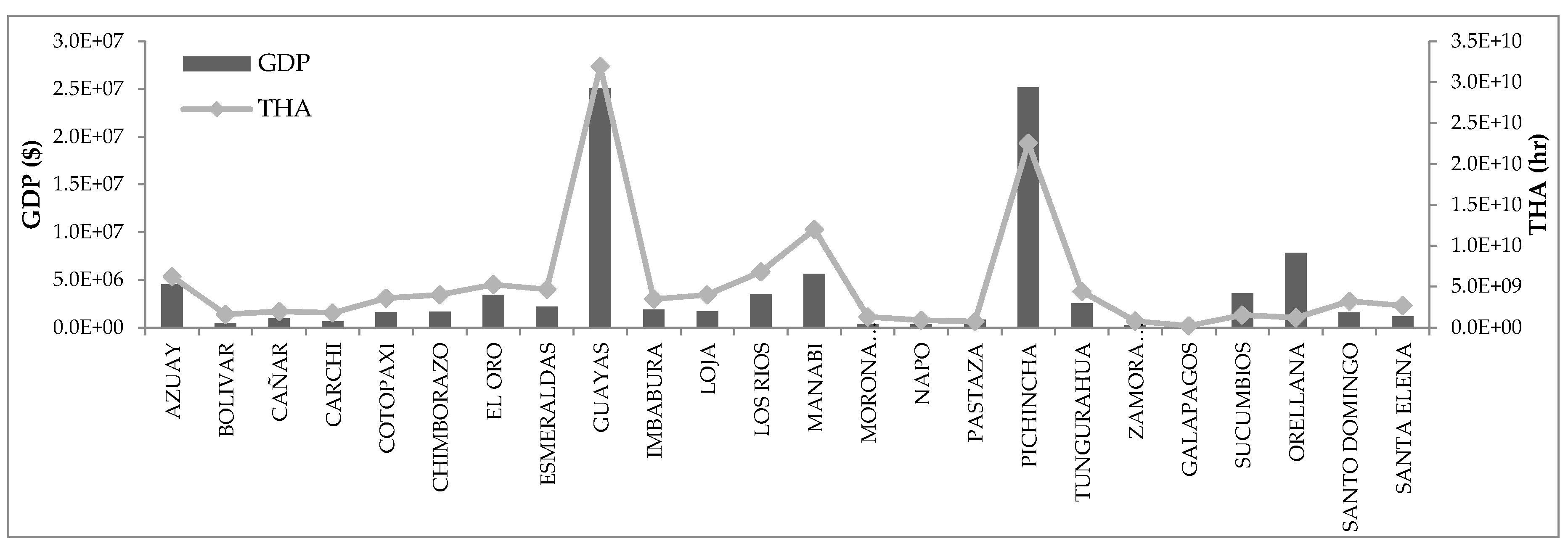
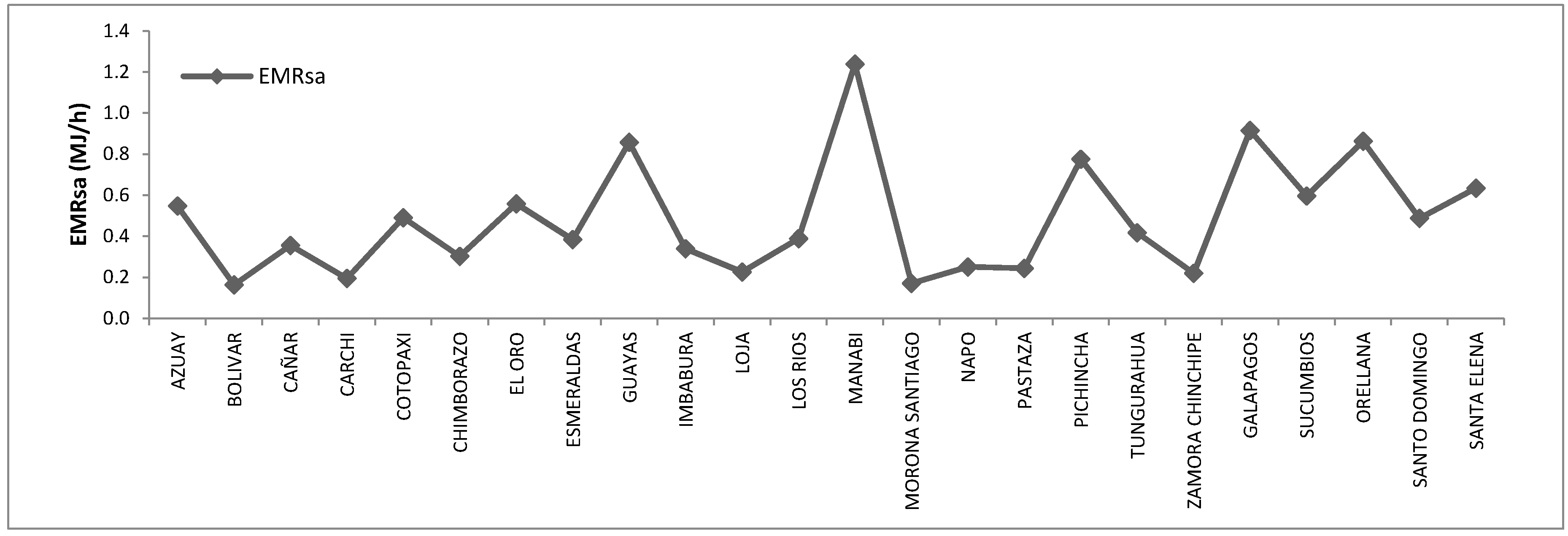
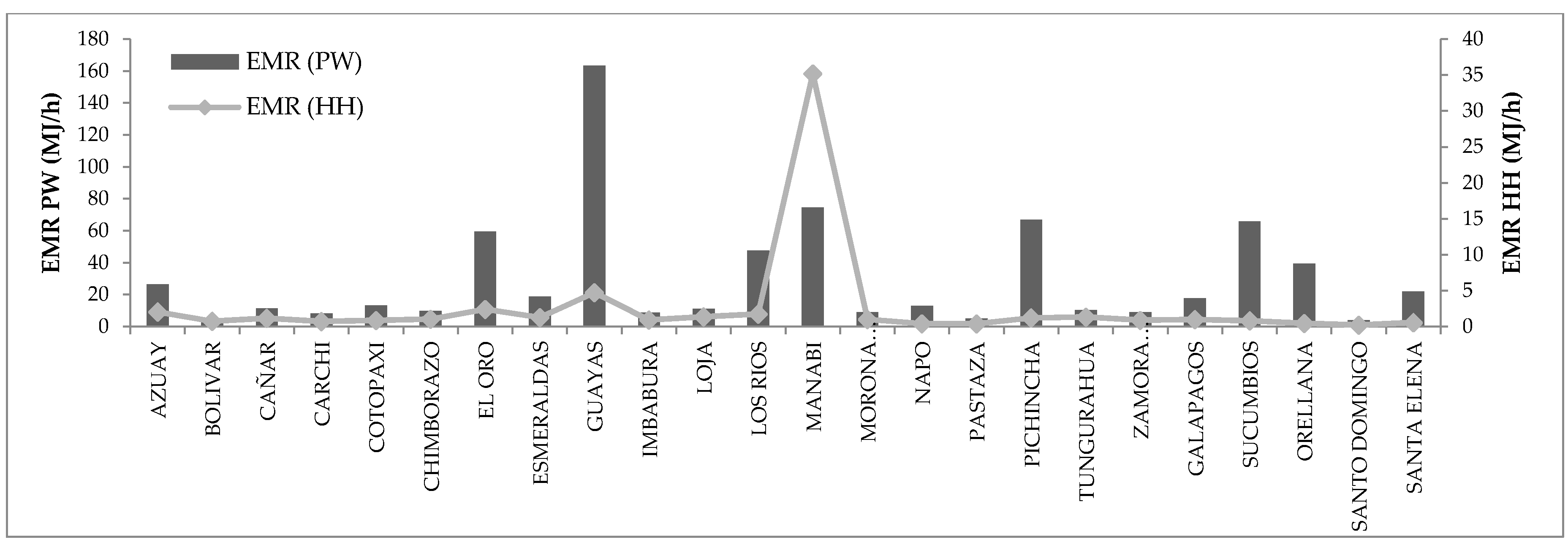
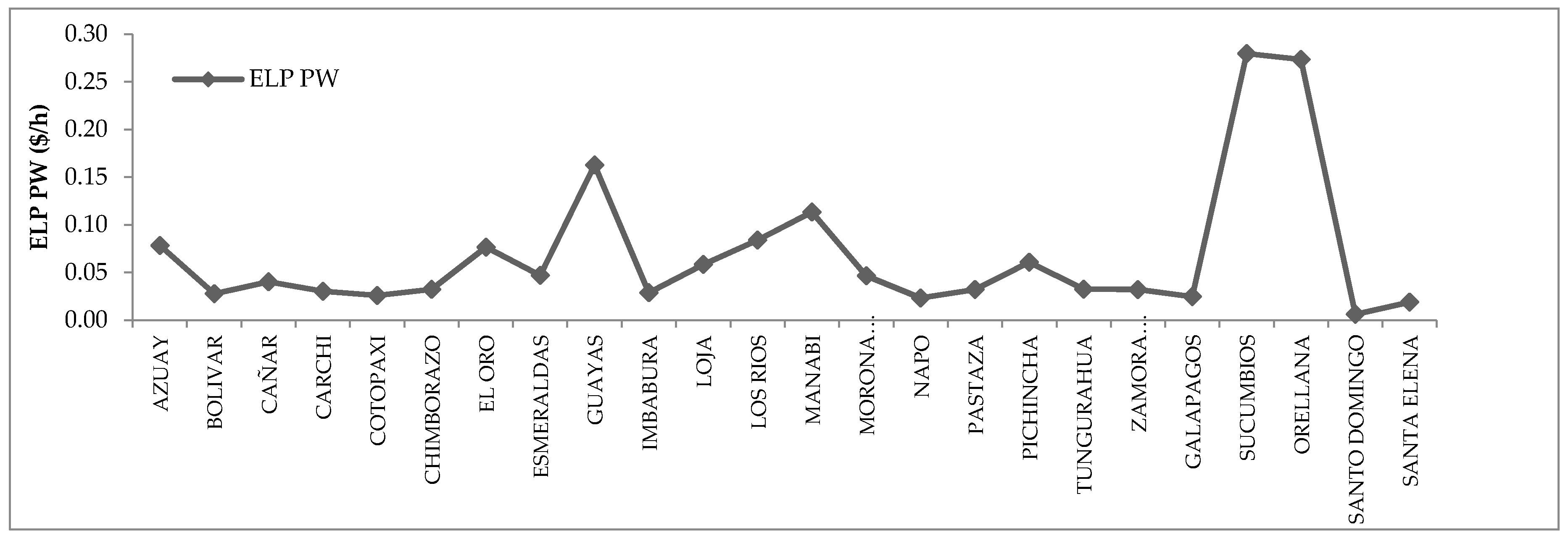
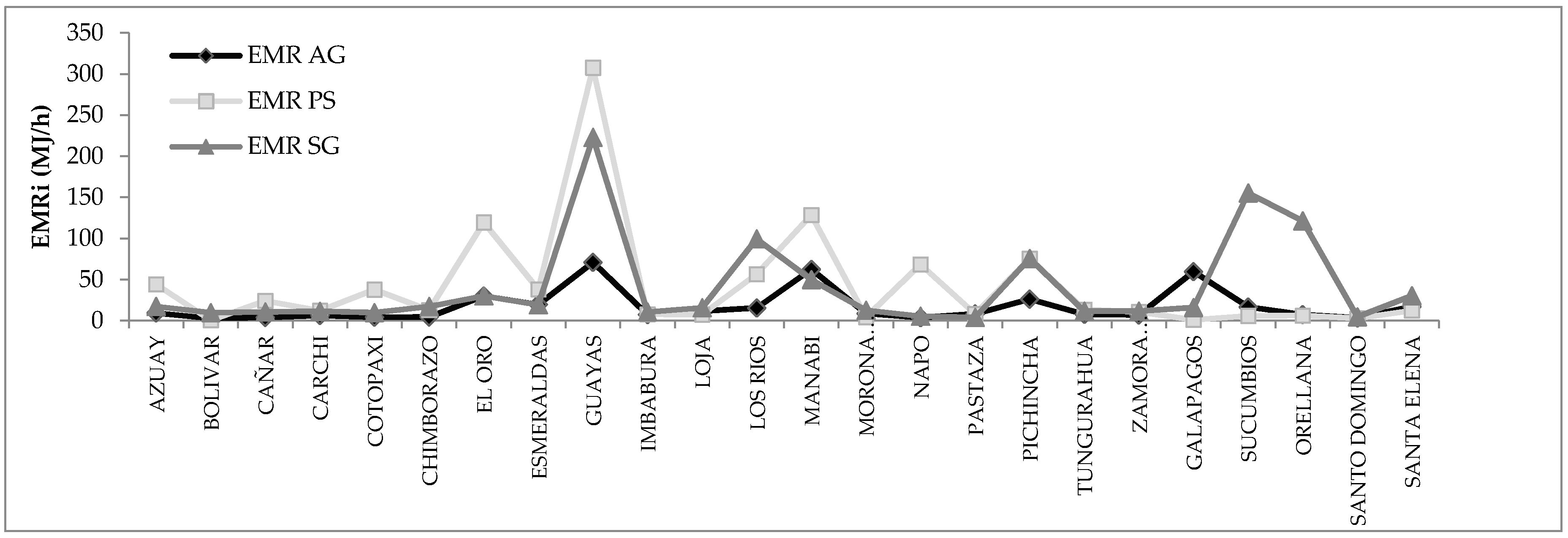
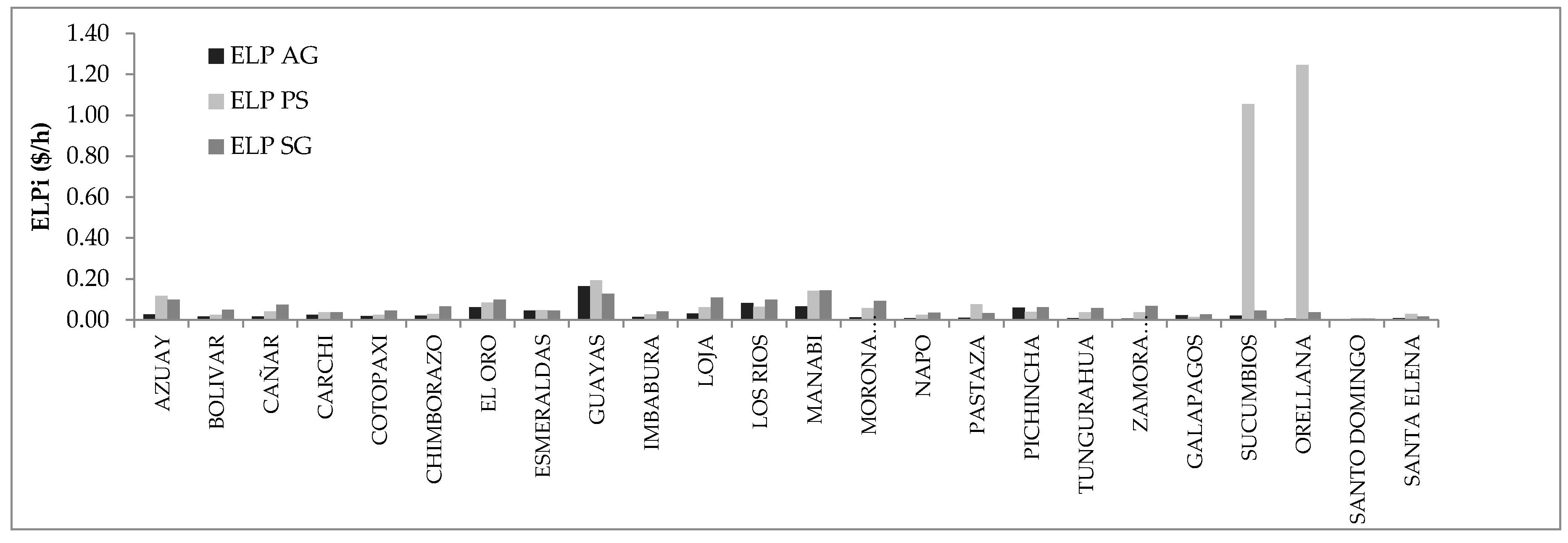

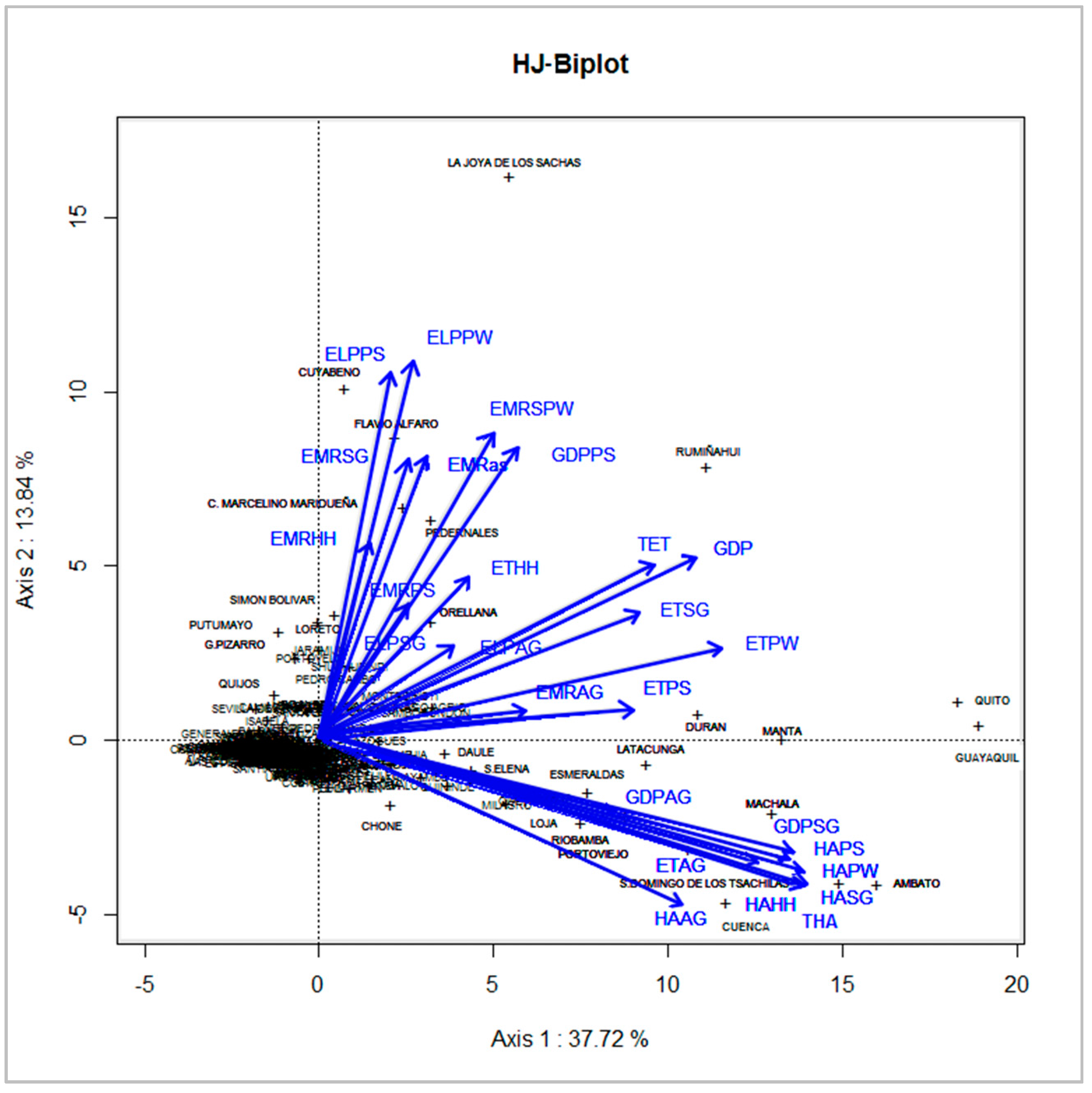
| Intensive Variable | Fund/Flow | Name of the Variable | Description | Unit & Calculation |
|---|---|---|---|---|
| TET | Flow | Total Energy Throughput | Total energy sources that are used for gerating electricity in an economy in one year | Megajoules (MJ) Total energy sources that are used for gerating electricity supply of Ecuador |
| THA | Fund | Total human activity | Total human time a society has available for conducting different activities | Hours (h) Total population times 8760 h |
| GDP | Flow | Gross domestic product | Added value generated by an economy in one year | US dollars ($) |
| ETi | Flow | Energy Throughput in activity i 1 | Energy sources that are used for gerating electricity in activity i, in one year | Megajoules (MJ) Energy sources that are used for gerating electricity equivalent of energy consumption in each economic sector |
| HAi | Fund | Human Activity in activity i | Human time a society has allocated to activity i | Hours (h) Working population in sector i × 46 working weeks × average working hours per week |
| GDPi | Flow | Added value generated by activity i | Sum of the value added from the various economic sectors | US dollars ($) |
| EMRSA | Flow/fund indicator | Exosomatic metabolic rate, average of the society | The amount of energy used per hour of human time for the whole society | MJ/h TET/THA |
| EMRi | Flow/fund indicator | Exosomatic metabolic rate for activity i | The amount of energy used per hour dedicated to each sector | MJ/h ETi/HAi |
| ELPi | Flow/fund indicator | Economic labor productivity for activity i | Added value per hour of working time in activity i | $/h GDPi/HAi |
| EEI | Flow/fund indicator | Economic Energy Intensity | Energy consumption per unit of added value | (MJ/$) TET/GDP |
| Axes | Eigenvalue | % of Variance | Cumulative % |
|---|---|---|---|
| 1 | 46.45 | 37.72 | 37.72 |
| 2 | 28.14 | 13.84 | 51.56 |
| 3 | 27.16 | 12.89 | 64.45 |
| MuSIASEM Variable | Axis 1 | Axis 2 | Axis 3 |
|---|---|---|---|
| THA | 916.56 | 82.8 | 0.64 |
| HAAG | 828.5 | 169.2 | 2.3 |
| HAPS | 939.03 | 59.48 | 1.49 |
| HASG | 931.5 | 67.47 | 1.03 |
| HAPW | 919.72 | 78.96 | 1.32 |
| HAHH | 916.25 | 83.16 | 0.59 |
| TET | 447.45 | 124.19 | 428.36 |
| ETHH | 104.39 | 122.34 | 773.27 |
| ETPW | 947.32 | 50.38 | 2.3 |
| ETSG | 859.8 | 136.49 | 3.71 |
| ETAG | 926.39 | 71.8 | 1.81 |
| ETPS | 987.75 | 9.38 | 2.87 |
| EMRSA | 46.08 | 318.75 | 635.17 |
| EMRHH | 11.51 | 177.46 | 811.03 |
| EMRSG | 90.3 | 867.63 | 42.07 |
| EMRAG | 979.83 | 20.01 | 0.16 |
| EMRPS | 296.8 | 684.05 | 19.15 |
| EMRPW | 246.17 | 750.85 | 2.98 |
| GDP | 634.41 | 148.9 | 216.69 |
| GDPSG | 946.66 | 52.39 | 0.94 |
| GDPPS | 201.96 | 438.08 | 359.95 |
| GDPAG | 941.74 | 54.4 | 3.86 |
| ELPPW | 39.6 | 633.93 | 326.47 |
| ELPSG | 403.17 | 557.43 | 39.4 |
| ELPPS | 24.01 | 617.26 | 358.73 |
| ELPAG | 668.27 | 329.34 | 2.39 |
© 2017 by the authors. Licensee MDPI, Basel, Switzerland. This article is an open access article distributed under the terms and conditions of the Creative Commons Attribution (CC BY) license (http://creativecommons.org/licenses/by/4.0/).
Share and Cite
Tejedor-Flores, N.; Vicente-Galindo, P.; Galindo-Villardón, P. Sustainability Multivariate Analysis of the Energy Consumption of Ecuador Using MuSIASEM and BIPLOT Approach. Sustainability 2017, 9, 984. https://doi.org/10.3390/su9060984
Tejedor-Flores N, Vicente-Galindo P, Galindo-Villardón P. Sustainability Multivariate Analysis of the Energy Consumption of Ecuador Using MuSIASEM and BIPLOT Approach. Sustainability. 2017; 9(6):984. https://doi.org/10.3390/su9060984
Chicago/Turabian StyleTejedor-Flores, Nathalia, Purificación Vicente-Galindo, and Purificación Galindo-Villardón. 2017. "Sustainability Multivariate Analysis of the Energy Consumption of Ecuador Using MuSIASEM and BIPLOT Approach" Sustainability 9, no. 6: 984. https://doi.org/10.3390/su9060984
APA StyleTejedor-Flores, N., Vicente-Galindo, P., & Galindo-Villardón, P. (2017). Sustainability Multivariate Analysis of the Energy Consumption of Ecuador Using MuSIASEM and BIPLOT Approach. Sustainability, 9(6), 984. https://doi.org/10.3390/su9060984







